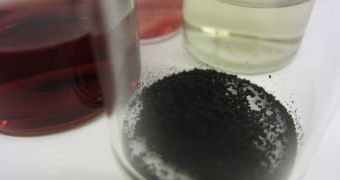Scientists at the Massachusetts Institute of Technology (MIT), in Cambridge, announce the creation of a type of hybrid copper-gold nanoparticle that is extremely effective at converting carbon dioxide into methane (CH4) or methanol (CH3OH).
CO2 is the primary chemical driving global warming and climate change today. Having the ability to turn it into fuels we can actually use, rather than simply release it into the air, would create a revolution in the way we produce and use energy.
Copper is part of a very select group of chemicals, which has the ability to turn carbon dioxide into hydrocarbon fuels with little energy usage. Scientists use it in the shape of an electrode through which an electrical voltage is applied. The current turns the copper into a catalyst.
But the metal also has some problems, such as the fact that it is not very stable. An old copper penny will turn green after a while, because the element is easily oxidized. What the MIT team did was find a way to make the chemical more stable.
The approach also boosts the speed of the reaction, preventing the formation of unwanted compounds, including carbon monoxide (CO) and formic acid. These issues were all resolved by fashioning the copper into nanoparticles, and adding gold to the mixture.
Unlike pure-copper nanoparticles, the gold-augmented ones needed far less energy (when placed on an electrode) to catalyze a reaction with CO2, and form hydrocarbon fuels. Details of why this happens appear in the latest issue of the top scientific journal Chemical Communications.
The work was made possible by funds secured from the US National Science Foundation (NSF). Possible applications include employing the new technology in carbon capture and storage (CCS) techniques. These could be used to soak up CO2 from power plant smokestacks.
If this can be done with acceptable costs, then researchers will essentially have created a system that continuously produces energy, a part of which will be reusable. “You normally have to put a lot of energy into converting carbon dioxide into something useful,” Kimberly Hamad-Schifferli says.
She is a co-author of the new study, and an associate professor of mechanical engineering and biological engineering at MIT.
“We demonstrated hybrid copper-gold nanoparticles are much more stable, and have the potential to lower the energy you need for the reaction,” Hamad-Schifferli concludes.

 14 DAY TRIAL //
14 DAY TRIAL //